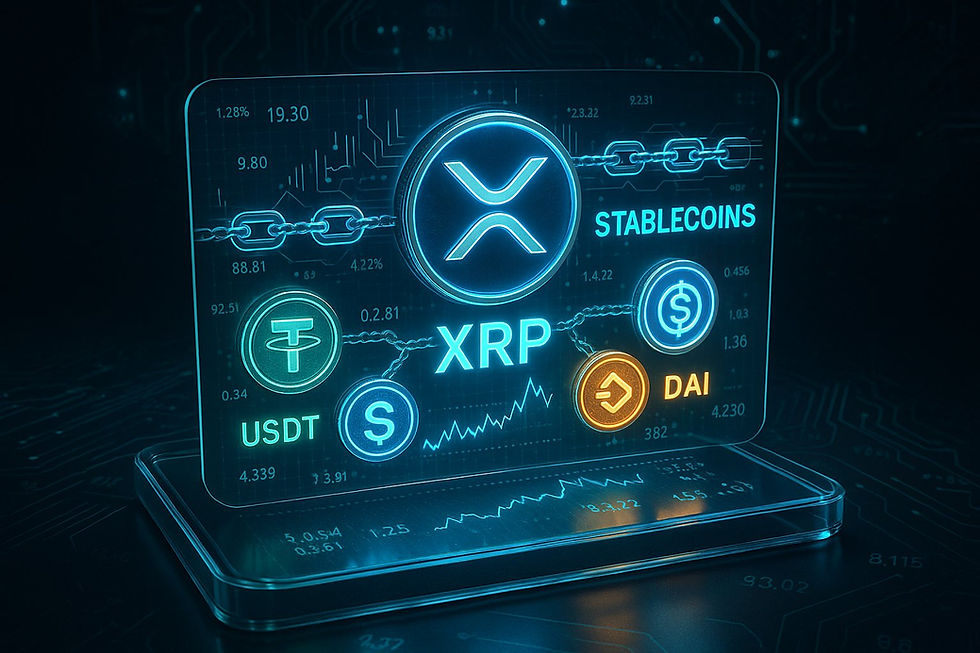Is XRP a Stablecoin? Important Information for a Crypto Investor
- The Master Sensei

- Sep 13
- 4 min read
Plenty of folks ask if XRP is a stablecoin, probably because it pops up so often in payments and banking. But no, XRP isn't a stablecoin—it's a volatile cryptocurrency, bouncing around in price like Bitcoin or Ethereum. Stablecoins, on the other hand, are built to hold a steady value, usually tied to something like the US dollar.

The confusion mostly comes from XRP’s role in cross-border payments and its connection to Ripple, which recently put out its own stablecoin, RLUSD. XRP was originally built to help banks and financial companies move money fast across borders, but its price can swing wildly from one day to the next.
Knowing the difference between XRP and real stablecoins matters if you’re thinking about investing in crypto or using it for payments. They serve different functions, even if they sometimes end up in the same financial systems.
Is XRP a Stablecoin? Key Facts and Comparisons
The World Bank actually called XRP a stablecoin back in 2021, but if you look at XRP’s price, it’s all over the place compared to true stablecoins like USDC and USDT. Ripple itself calls XRP a bridge currency, not a pegged asset.
World Bank and Regulatory Classifications
In 2021, the World Bank’s report "Central Bank Digital Currencies for Cross-Border Payments" labeled XRP as a stablecoin. They focused on how XRP speeds up cross-border payments.
This label stirred up a lot of debate in the crypto world. Most experts pushed back, arguing that XRP doesn’t have the key feature of a real stablecoin.
Key differences from a regulatory lens:
XRP isn’t pegged to fiat currency
Its price moves with market demand
There’s no reserve backing like USDC or USDT
The SEC hasn’t called XRP a stablecoin in its ongoing legal battle with Ripple. Regulators are still hashing out where XRP fits into existing financial categories.
Price Stability and Volatility Analysis
XRP’s price swings way more than any true stablecoin. After the World Bank report, XRP actually dropped about 50%—so much for price stability.
XRP vs Traditional Stablecoins:

People sometimes think XRP is a stablecoin because it seems less wild than Bitcoin or Ethereum. But that’s only true if you’re comparing it to those super volatile coins, not to actual stablecoins.
XRP’s price moves with market supply and demand. Stablecoins keep their value using reserves or algorithms.
Bridge Currency vs Pegged Stablecoins
Ripple built XRP as a bridge currency for cross-border payments, not as a stablecoin. The XRP Ledger lets you swap between different fiat currencies and digital assets.
Bridge currencies connect financial systems, but don’t need to keep a fixed price. XRP fills that role by providing liquidity for global transactions.
Bridge Currency Functions:
Links different currencies
Speeds up transactions
Cuts settlement time
No need for a fixed value
Ripple rolled out its own stablecoin, Ripple USD (RLUSD), for clients who want digital dollars that don’t move in price. Clearly, Ripple knows there’s a difference between XRP and stablecoins.
The XRP Ledger holds around $171 million in stablecoins right now. That’s a solid sign that XRP and stablecoins play separate roles in the same system.
How XRP and Stablecoins Differ in Real-World Use
XRP and stablecoins play different parts in digital payments. XRP acts as a bridge for instant settlements, while stablecoins focus on holding steady value for storing and transferring money. These differences really shape how banks and users put each to work.

Liquidity and Settlement Speed
The XRP Ledger (XRPL) handles about 1,500 transactions per second. That speed makes XRP great for real-time cross-border payments between banks and big institutions.
Stablecoins like USDC and USDT work a bit differently, depending on the blockchain. USDC on Ethereum processes fewer transactions per second but keeps its price steady. USDT is accepted almost everywhere, but settlement times can be slower on some networks.
XRP’s On-Demand Liquidity (ODL) lets banks skip pre-funded accounts. They just convert local currency to XRP, send it, and swap it for the destination currency—done in seconds. No need to stash money in foreign accounts.
With stablecoins, you’ve got to hold the tokens before sending them. Banks have to get USDC or USDT first, which adds a few steps. On the upside, the receiver gets a predictable amount because stablecoins stick close to $1.
Role in Cross-Border Payments
Banks use XRP as a bridge between currencies. For example, a bank might send Japanese yen, convert it to XRP, shoot it across borders, then convert it to Mexican pesos—all in seconds.
Stablecoins act more like digital cash. Banks and companies use them to send steady value across borders. The receiver always knows how much they’ll get, since USDT or USDC don’t really change in value.
XRP cuts out currency risk during those quick transfers. Sure, its price can change, but transactions finish so fast that it rarely matters. Banks also avoid having to hold foreign currency reserves.
Stablecoins get rid of price risk altogether while you’re storing or transferring them. Companies can hold USDC for months without worrying about value swings. That’s a big deal for businesses that need steady accounting and reliable cash flow.
XRPL, RLUSD, and Evolving Ecosystems
Ripple launched RLUSD as a dollar-pegged stablecoin on both XRPL and Ethereum networks. This move tries to bridge XRP's speed with the stability of a classic stablecoin.
The XRP Ledger now supports multiple assets. People can hold RLUSD for steady value and use XRP when they want fast transfers. Financial institutions finally get both options on a single blockchain—pretty handy, honestly.
RLUSD on XRPL settles in just 3-5 seconds, while Ethereum usually takes minutes. So users can enjoy stablecoin perks with XRP's quickness. Banks get to pick the tool that fits each payment, which feels like the flexibility they’ve been asking for.
Traditional stablecoins like USDC are still popular on Ethereum and other networks. They have a strong reputation and big market share. But they just don't offer XRP's payment features or its focus on institutional banking.
















































Comments